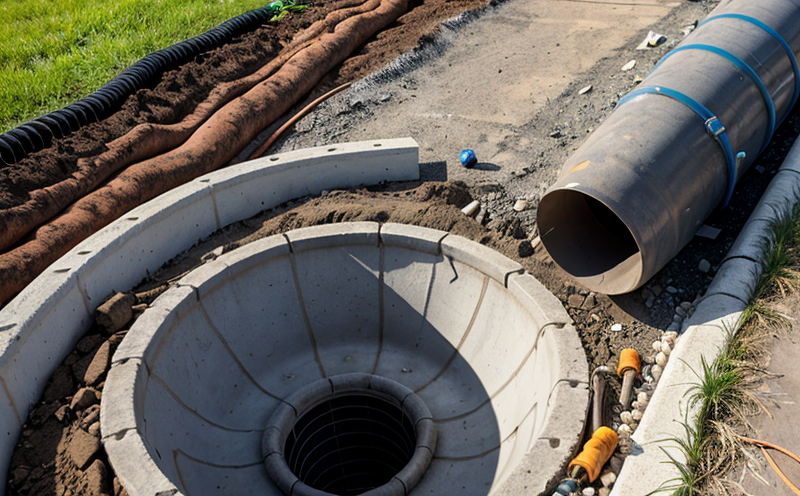Sewer line installation inspection
Ensuring the quality and integrity of sewer lines is essential for maintaining efficient wastewater management systems. Sewer line installation inspection involves a series of tests that verify the compliance of newly installed or repaired sewer pipes with relevant standards and specifications. This process is critical to prevent future leaks, blockages, and failures that could compromise public health and environmental safety.
The inspection typically includes visual checks for any visible defects such as cracks, misalignments, or improper connections. Additionally, non-destructive testing (NDT) methods like CCTV surveys are used to examine the internal condition of the pipes in real-time. These inspections help identify potential issues early on and ensure that all work is carried out according to best practices.
One of the most important aspects of sewer line installation inspection is the verification against international standards such as ASTM C150, EN 12436, and ISO 9079. These guidelines provide clear criteria for acceptable pipe materials, dimensions, and tolerances. Compliance with these standards ensures that the installed systems perform reliably under varying conditions.
Another key element is ensuring proper bedding and backfilling around the newly laid pipes to support long-term stability and durability. This involves checking the quality of the trench backfill material as well as its compaction level using penetrometers or nuclear densometers. Proper backfilling prevents settlement issues which can lead to structural damage over time.
Environmental considerations also play a significant role in sewer line installation inspections. Modern practices emphasize sustainable construction techniques that minimize disruption to local ecosystems while enhancing the overall resilience of infrastructure against climate change impacts like increased rainfall volumes or ground subsidence.
The inspection process is not just about detecting problems; it’s equally important for documenting findings accurately so they can be reviewed by stakeholders involved in project planning and execution. Comprehensive reports detailing observations, measurements, photographs, and recommendations are prepared to guide future maintenance activities if necessary.
In conclusion, thorough sewer line installation inspections ensure reliable performance of drainage systems throughout their service life cycle. By adhering strictly to established protocols and leveraging advanced technologies, professionals can maintain high standards of hygiene, safety, and environmental responsibility within built environments.
Applied Standards
The inspection of sewer line installations is governed by several international standards designed to ensure quality control and consistency across different regions. Key among these are:
- ASTM C150 / EN 976: Specifies requirements for Portland cement concrete used in sewers.
- EN 12436: Covers the design, construction, and maintenance of urban drainage systems.
- ISO 9079: Provides guidelines on quality assurance during the installation of pipelines.
These standards provide a framework for manufacturers, contractors, and inspectors to follow when carrying out sewer line inspections. They help maintain uniformity in procedures and criteria, ensuring that all parties involved are working towards common goals aimed at delivering safe, functional infrastructure.
Why Choose This Test
Selecting the right inspection method for your sewer line installation is crucial to guaranteeing long-term functionality and reliability. Here’s why choosing this test can benefit you:
Enhanced Safety: Regular inspections identify potential hazards early on, minimizing risks associated with blockages or failures in critical areas.
- Reduces the likelihood of accidents due to blocked drains leading to floods.
- Prevents contamination of water supplies from improperly functioning sewage systems.
Cost Efficiency: Early detection allows for timely repairs, preventing costly replacements later down the line.
- Avoids unnecessary expenditure on overhauls caused by undetected defects during initial stages.
- Ensures efficient use of resources through targeted interventions rather than blanket approaches.
Compliance Assurance: Adherence to relevant standards guarantees that all aspects meet regulatory requirements, reducing the chances of legal penalties or disputes over non-conformance.
- Facilitates smoother interactions with regulatory bodies by providing clear documentation of compliance efforts.
- Simplifies certification processes for projects meeting stringent quality benchmarks set forth by governing authorities.
Environmental Protection: Properly installed and maintained sewer lines contribute significantly to preserving natural habitats around built environments.
- Promotes biodiversity by minimizing disruptions to local flora and fauna through careful construction practices.
- Reduces pollution levels in nearby water bodies resulting from effective management of waste flows.
Customer Satisfaction: Providing superior service backed up by robust evidence enhances reputation among clients who appreciate reliability and professionalism.
- Builds trust through transparent communication about ongoing maintenance activities and expected outcomes.
- Encourages repeat business from satisfied customers appreciating consistent delivery of promised services.
In summary, choosing this test offers multiple advantages ranging from enhanced safety to improved cost-effectiveness. It ensures that your sewer line installations not only meet but exceed expectations in terms of performance and longevity.





